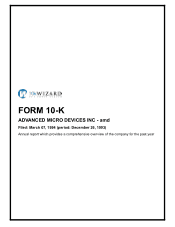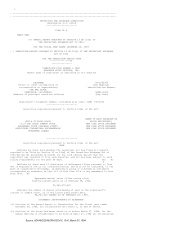AMD 1993 Annual Report Download - page 7
Download and view the complete annual report
Please find page 7 of the 1993 AMD annual report below. You can navigate through the pages in the report by either clicking on the pages listed below, or by using the keyword search tool below to find specific information within the annual report.-
 1
1 -
 2
2 -
 3
3 -
 4
4 -
 5
5 -
 6
6 -
 7
7 -
 8
8 -
 9
9 -
 10
10 -
 11
11 -
 12
12 -
 13
13 -
 14
14 -
 15
15 -
 16
16 -
 17
17 -
 18
18 -
 19
19 -
 20
20 -
 21
21 -
 22
22 -
 23
23 -
 24
24 -
 25
25 -
 26
26 -
 27
27 -
 28
28 -
 29
29 -
 30
30 -
 31
31 -
 32
32 -
 33
33 -
 34
34 -
 35
35 -
 36
36 -
 37
37 -
 38
38 -
 39
39 -
 40
40 -
 41
41 -
 42
42 -
 43
43 -
 44
44 -
 45
45 -
 46
46 -
 47
47 -
 48
48 -
 49
49 -
 50
50 -
 51
51 -
 52
52 -
 53
53 -
 54
54 -
 55
55 -
 56
56 -
 57
57 -
 58
58 -
 59
59 -
 60
60 -
 61
61 -
 62
62 -
 63
63 -
 64
64 -
 65
65 -
 66
66 -
 67
67 -
 68
68 -
 69
69 -
 70
70 -
 71
71 -
 72
72 -
 73
73 -
 74
74 -
 75
75 -
 76
76 -
 77
77 -
 78
78 -
 79
79 -
 80
80 -
 81
81 -
 82
82 -
 83
83 -
 84
84 -
 85
85 -
 86
86 -
 87
87 -
 88
88 -
 89
89 -
 90
90 -
 91
91 -
 92
92 -
 93
93 -
 94
94 -
 95
95 -
 96
96 -
 97
97 -
 98
98 -
 99
99 -
 100
100 -
 101
101 -
 102
102 -
 103
103 -
 104
104 -
 105
105 -
 106
106 -
 107
107 -
 108
108 -
 109
109 -
 110
110 -
 111
111 -
 112
112 -
 113
113 -
 114
114 -
 115
115 -
 116
116 -
 117
117 -
 118
118 -
 119
119 -
 120
120 -
 121
121 -
 122
122 -
 123
123 -
 124
124 -
 125
125 -
 126
126 -
 127
127 -
 128
128 -
 129
129 -
 130
130 -
 131
131 -
 132
132 -
 133
133 -
 134
134 -
 135
135 -
 136
136 -
 137
137 -
 138
138 -
 139
139 -
 140
140 -
 141
141 -
 142
142 -
 143
143 -
 144
144 -
 145
145 -
 146
146 -
 147
147 -
 148
148 -
 149
149 -
 150
150 -
 151
151 -
 152
152 -
 153
153 -
 154
154 -
 155
155 -
 156
156 -
 157
157 -
 158
158 -
 159
159 -
 160
160 -
 161
161 -
 162
162 -
 163
163 -
 164
164 -
 165
165 -
 166
166 -
 167
167 -
 168
168 -
 169
169 -
 170
170 -
 171
171 -
 172
172 -
 173
173 -
 174
174 -
 175
175 -
 176
176 -
 177
177 -
 178
178 -
 179
179 -
 180
180 -
 181
181 -
 182
182 -
 183
183 -
 184
184 -
 185
185 -
 186
186 -
 187
187 -
 188
188 -
 189
189 -
 190
190 -
 191
191 -
 192
192 -
 193
193 -
 194
194 -
 195
195 -
 196
196 -
 197
197 -
 198
198 -
 199
199 -
 200
200 -
 201
201 -
 202
202 -
 203
203 -
 204
204 -
 205
205 -
 206
206 -
 207
207 -
 208
208 -
 209
209 -
 210
210 -
 211
211 -
 212
212 -
 213
213 -
 214
214 -
 215
215 -
 216
216 -
 217
217 -
 218
218 -
 219
219 -
 220
220 -
 221
221 -
 222
222 -
 223
223 -
 224
224 -
 225
225 -
 226
226 -
 227
227 -
 228
228 -
 229
229 -
 230
230 -
 231
231 -
 232
232 -
 233
233 -
 234
234 -
 235
235 -
 236
236 -
 237
237 -
 238
238 -
 239
239 -
 240
240 -
 241
241 -
 242
242 -
 243
243 -
 244
244 -
 245
245 -
 246
246 -
 247
247 -
 248
248 -
 249
249 -
 250
250 -
 251
251 -
 252
252 -
 253
253 -
 254
254 -
 255
255 -
 256
256 -
 257
257 -
 258
258 -
 259
259 -
 260
260 -
 261
261 -
 262
262 -
 263
263 -
 264
264 -
 265
265 -
 266
266 -
 267
267 -
 268
268 -
 269
269 -
 270
270 -
 271
271 -
 272
272 -
 273
273 -
 274
274 -
 275
275 -
 276
276 -
 277
277 -
 278
278 -
 279
279 -
 280
280 -
 281
281 -
 282
282 -
 283
283 -
 284
284 -
 285
285 -
 286
286 -
 287
287 -
 288
288 -
 289
289 -
 290
290 -
 291
291 -
 292
292 -
 293
293 -
 294
294 -
 295
295 -
 296
296 -
 297
297 -
 298
298 -
 299
299 -
 300
300 -
 301
301 -
 302
302 -
 303
303 -
 304
304 -
 305
305 -
 306
306 -
 307
307 -
 308
308 -
 309
309 -
 310
310 -
 311
311 -
 312
312 -
 313
313 -
 314
314 -
 315
315 -
 316
316 -
 317
317 -
 318
318 -
 319
319 -
 320
320 -
 321
321 -
 322
322 -
 323
323 -
 324
324 -
 325
325 -
 326
326 -
 327
327 -
 328
328 -
 329
329 -
 330
330 -
 331
331 -
 332
332 -
 333
333 -
 334
334 -
 335
335 -
 336
336 -
 337
337 -
 338
338 -
 339
339 -
 340
340 -
 341
341 -
 342
342 -
 343
343 -
 344
344 -
 345
345 -
 346
346 -
 347
347 -
 348
348 -
 349
349 -
 350
350 -
 351
351 -
 352
352 -
 353
353 -
 354
354 -
 355
355 -
 356
356 -
 357
357 -
 358
358 -
 359
359 -
 360
360 -
 361
361 -
 362
362 -
 363
363 -
 364
364 -
 365
365 -
 366
366 -
 367
367 -
 368
368 -
 369
369 -
 370
370 -
 371
371 -
 372
372 -
 373
373 -
 374
374 -
 375
375 -
 376
376 -
 377
377 -
 378
378 -
 379
379 -
 380
380 -
 381
381 -
 382
382 -
 383
383 -
 384
384 -
 385
385 -
 386
386 -
 387
387 -
 388
388 -
 389
389 -
 390
390 -
 391
391 -
 392
392 -
 393
393 -
 394
394
 |
 |
3
embedded microprocessors contained in peripherals or other coprocessors
which perform certain functions such as arithmetic calculations. The iAPX
architecture, originally developed by Intel Corporation, has been the leading
architecture for personal computer microprocessors. AMD's strategy has been to
serve as an alternative source for iAPX microprocessors, introducing products
at comparable prices to competitive products, but with additional
customer-driven features. The Corporation in 1993 entered into a license
agreement with Microsoft(Registered Trademark), the personal computer
industry's leading supplier of operation systems software, pursuant to which
the Microsoft(Registered Trademark) Windows(Trademark) compatible logo now
appears on AMD's microprocessor packaging and advertising indicating that the
Corporation's product is compatible with such software. This approach is also
representative of the computer industry's shift from an emphasis on hardware
compatibility to software compatibility.
The PC market is currently divided into laptop, personal information
devices, desktop and portable varieties, and AMD plays a significant role in
such arenas. The Corporation has developed the Am386(Registered Trademark)
microprocessor, which is designed to meet the specifications of the Intel 80386
microprocessor. The Am386 family of microprocessors accounted for approximately
seventeen percent (17%) of the Corporation's 1993 revenues. The Corporation
believes that its success with the Am386 family has been largely due to its
competitive features and pricing coupled with customers' demand for a
reasonably priced second source. As is often the case in the semiconductor
industry, the average selling price of the Am386 has experienced significant
downward pressure as it approaches the end of its product life cycle. Most
computer manufacturers have made a transition from the 386 to the 486 family of
microprocessors.
The Corporation now offers a Am486(Trademark) family of products. The
Corporation began shipping Am486DX products in the second quarter of 1993, and
began volume shipment of its Am486SX products in 1994. The Corporation's 486DX
and 486SX products are the subject of microcode litigations with Intel
Corporation. (For more information see Item 3, Legal Proceedings, Numbers 2-8).
The Corporation is currently in the process of developing additional Am486
products. It is anticipated that development of such 486 products will be
completed by the end of 1994.
The Corporation is currently developing its next generation of CPU
microprocessor products known as the K series, based on superscalar RISC type
architecture. The K series products will be compatible with software such as
Microsoft(Registered Trademark) Windows(Trademark) currently compatible with
the X86 CPU microprocessors. The Corporation anticipates that the development
of the first K series products will be completed sometime in late 1994. The
Corporation currently offers a family of RISC microprocessors for embedded
control applications discussed below.
The future outlook for the Corporation's microprocessor products is highly
dependent on the timing of new product introductions, the outcome of its various
litigation matters with Intel, and other microprocessor market conditions.
Applications Solutions Products
Computer Systems, Interfaces and Mass Storage. The Corporation offers a
range of products which are utilized in a variety of computer systems. Computer
systems include a peripheral chip which is a special-purpose component that
works with central processing units, managing selected input/output or other
system functions. Other systems components control disk drives, keyboards and
printers. Through the use of communication peripherals, computers can operate in
networks and communicate locally and over long distances.
Many of these systems require a high-performance microprocessor for
embedded control. The Corporation's proprietary Am29000(Trademark) family of
RISC microprocessors is used extensively by a wide range of customers for
embedded control applications. Examples of these applications include
high-performance laser printer controllers, high-resolution graphics
controllers, communications controllers, and accelerator cards. Many
manufacturers, such as Motorola, Intel, IDT, National Semiconductor and Texas
Instruments offer RISC-based microprocessors which compete with the Am29000
family in certain applications. The Corporation expects that the RISC
microprocessor market will continue to grow.
2
Source: ADVANCED MICRO DEVIC, 10-K, March 07, 1994
